6.04.2020
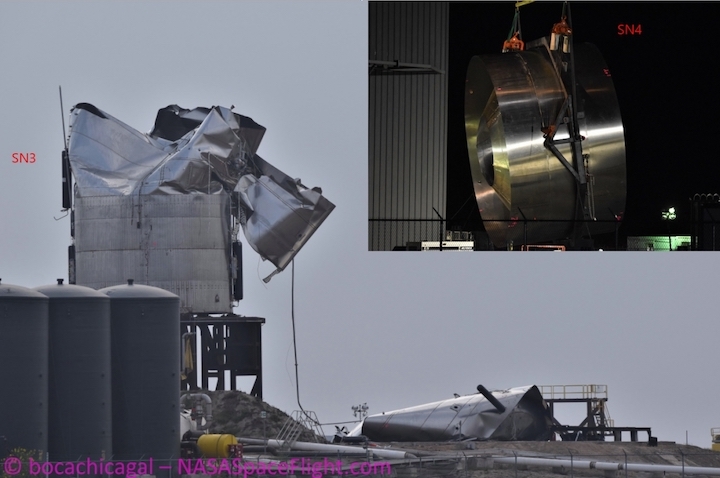
SpaceX Starship SN3, the latest iteration of Starship test vehicles, was lost during testing at the launch site in Boca Chica, Texas. The incident occurred during proof testing on Friday morning. However, Elon Musk has since clarified the issue was the result of incorrect commanding resulting in the loss of pressure, as opposed to any material issue with the Starship build. As a result, SN4 will not require alternations to its structure, with construction work on the next Starship already taking place.
(Lead photos by BocaChicaGal for NSF)
The SN3 (Serial Number 3) vehicle incorporated lessons learned from previous vehicles and test articles and took advantage of improved manufacturing techniques and expanded facilities at SpaceX’s South Texas launch facility.
The next round of testing began this week with cryogenic proof testing. These tests saw the vehicle filled with liquid nitrogen at cryogenic temperatures and flight pressures. Proof testing began on Thursday and continued through to Friday morning when SN3 failed during what appeared to be the end of the test.
With Elon Musk noting “we will see what data review says in the morning, but this may have been a test configuration mistake,” on Twitter and the first-look observations, the fault may have been related to detanking or an out of spec pressurization status, rather than another structural failure under pressure.
This was later confirmed in later tweets, with Mr. Musk adding specifics as to the cause of the failure.
“There are redundant pressure control valves. It’s a new system and SN3 was simply commanded wrong. Rockets are hard. Good news is that this was a test configuration error, rather than a design or build mistake. Not enough pressure in the LOX tank ullage to maintain stability with a heavy load in the CH4 tank. This was done with N2.”
Prior Starship test vehicles have had their campaigns cut short by failed cryogenic testing, including the last flight vehicle SpaceX rolled to the Boca Chica launch pad, Starship SN1. However, the previous losses were due to the vehicles failing to deal with pressurization testing at a structural level. Had SN3’s testing avoided a commanding issue, it would have likely completed the proof testing without issue.
SpaceX’s first vehicle in Boca Chica, named Starhopper, was the first Starship test vehicle to fly under power from the Raptor rocket engine. A static fire and a tethered hop test was conducted using Raptor SN2 in April 2019. A second static fire, and two free flights to 18 meters and 150 meters in altitude, were completed in July and August 2019 using Raptor SN6.
Starhopper was then retired in favor of Starship Mk1, which was originally intended to advance the Starship flight test program to higher altitudes. However, SpaceX decided not to fly the Mk1 vehicle, and instead focus on an improved design named Mk3. On November 20, 2019, the Mk1 vehicle completed a destructive cryogenic pressure test that destroyed the vehicle.
SpaceX also built individual test tanks to continue improving manufacturing methods. One tank was tested until destruction on January 10, reaching a pressure of 7.1 bar. This was above the 6 bar pressure required for orbital flight.
A second test tank reached 8.5 bar during a destructive test on January 29. This marked the 1.4 safety factor over the 6 bar orbital flight requirement.
The updated Starship Mk3 design was renamed Starship SN1 and rolled to the launch pad to continue the flight test program. But on February 28, the SN1 vehicle was also destroyed during cryogenic testing.
SpaceX fabricated a test tank designated SN2 to complete further testing. On March 8, the tank was tested successfully at cryogenic temperatures and flight pressures, including simulated engine thrust loads. Unlike other test tanks, the test was not to destruction.

Starship SN3 stacking operations at the Boca Chica assembly building – via BocaChicaGal for NSF
Starship SN3 is the culmination of all of these test articles. The vehicle was stacked in a new assembly building, beginning in mid-March. The vehicle was rolled to the launch pad and lifted onto the launch mount on March 29. Pending final preparations and checkouts at the pad.
The SN3 vehicle notably featured a new internally mounted, deployable leg design, which is visible in photos shared by SpaceX CEO Elon Musk. Musk noted that the legs will be longer starting with Starship SN4. SN3 does not have a nosecone, nor forward or aft fins. The aerodynamic surfaces are likely unnecessary for the low altitude, low-speed test flights planned for Starship SN3.
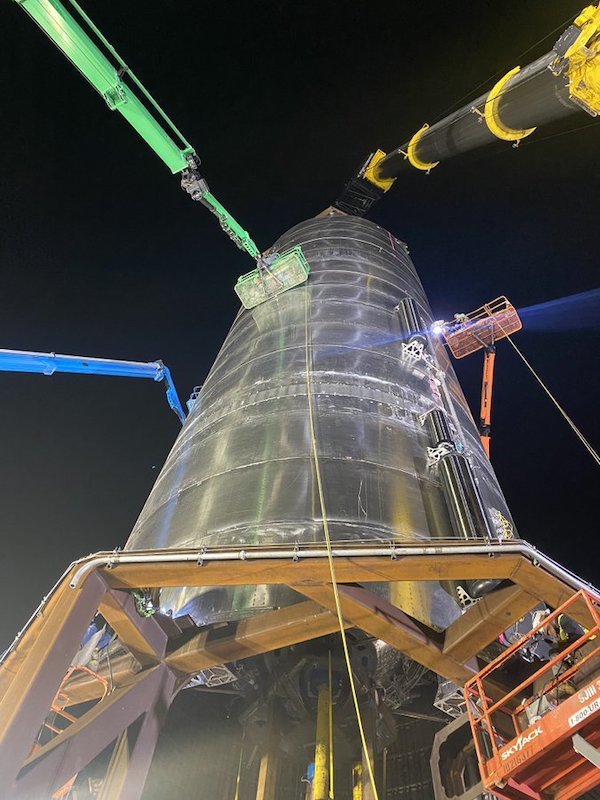

Following the completion of cryogenic pressure testing, the vehicle was to be prepared for those test flights. A single Raptor engine was originally planned to be installed on Starship SN3, although it had since changed to using three Raptors that were to be installed the day after a successful cryo test.
These Raptors will now be used on SN4, with Elon Musk posting a photo of the trio on Twitter.

He also added that some of SN3’s hardware, namely the thrust structure that survived the testing incident will be reused.
Should all go well with SN4’s proof testing, the vehicle – consistent with previous test campaigns – would have incrementally moved towards engine firings and flights.
A static fire test of the engine on SN3 was originally expected no sooner than April 1, but the beach closures which indicated this schedule were canceled early Tuesday. Closures originally associated with a 150 meter hop test was scheduled from 9:00 AM to 11:59 PM local time (14:00 to 04:59 UTC) daily from April 6 to April 8. All of those dates were postponed and will be realigned for around one month when SN4 arrives at the launch site.
The static fire and hop test timeline is dependant on successful cryogenic testing, engine installation, and fueling tests. The successful Starhopper campaign utilized a similar approach to that was expected for SN3.
This path will now fall on the shoulders of SN4, which has already begun construction.
Over the weekend, one of SN4’s Bulkheads was flipped, in preparation for following a similar stacking process as SN3. Several steel rings – potentially all for SN4 – were also being transported around the Boca Chica base over the past few days.
One SN4 has arrived at the launch site, the vehicle will undergo proof testing and be fueled for a potential static fire, to allow SpaceX teams will monitor the vehicle’s systems. If the fueling tests are successful, the teams can then continue into a static fire test. If any issues arise during fueling, the teams can take corrective action before another fueling attempt.
Due to the iterative nature of the test campaign, schedule changes and delays are highly likely.
Only after a successful static fire test can Starship SN4 conduct a test flight, expected to be a vertical takeoff, vertical landing flight to 150 meters in altitude. This was the path for SN3 and will likely push SN3’s test campaign to SN4.

Starship SN4 hardware at the Boca Chica build site – via BocaChicaGal for NSF
SN4 was set for high altitude flights, likely seeing a more complete Starship vehicle, consisting of a nosecone and aerodynamic fins, as well as multiple Raptor engines. The high altitude flights would also include the first in-flight re-ignition of a Raptor engine.
It is likely the path will be refined to involving SN4 with SN3’s test objectives of completing a hop, before SN5 takes on the high altitude flight test.
SpaceX has a goal of an orbital test flight this year. Musk recently noted that he hopes “Starship will have enough flight history to substitute for Dragon for NASA missions,” including the Cargo and Crew Dragon V2 vehicles, and the newly announced Dragon XL cargo spacecraft. The Starship vehicle and associated Super Heavy booster will eventually play a critical role in SpaceX’s overarching Mars colonization goals.
Quelle: NS
----
Update: 18.04.2020
.
SpaceX is about to reuse (part of) a Starship rocket
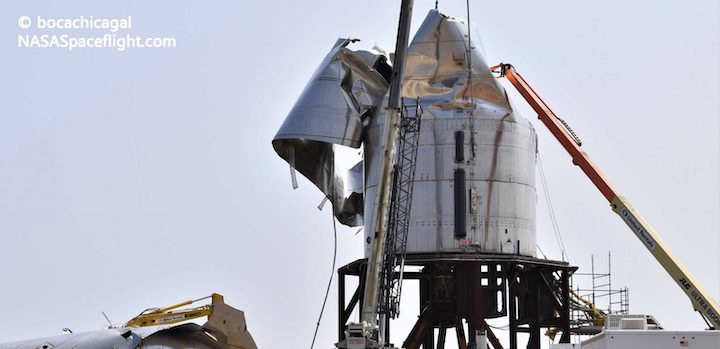
SpaceX has apparently decided to reuse a large section of a Starship prototype that was accidentally destroyed during testing earlier this month, a first for the next-generation rocket.
While not quite the same kind of ‘reuse’ SpaceX has largely pioneered with its vertically-landing Falcon rocket boosters, the company’s decision to reuse an unflown section of a former Starship prototype is yet another sign of its prioritization of efficiency and speed. The Starship SN3 hardware SpaceX has chosen to repurpose on Starship SN4 is relatively straightforward relative to almost all other sections of the newest prototype, but it should still save the company a not-insignificant amount of time and money.
For SpaceX, a combination of extraordinary speed and efficiency at its nascent South Texas Starship factory is allowing the company to accomplish feats that would otherwise be impossible. At least as important, fast and cheap Starship manufacturing has meant that SpaceX is far more willing (perhaps even a little too willing) to take risks with any given prototype, partly explaining why the company is about to complete its fourth full-scale Starship in as many months.

Starship SN3’s skirt – including internal plumbing, landing legs, and more – was removed from the rest of the ship’s remains and moved back to the build site on April 7th. (NASASpaceflight – bocachicagal)
Speaking on April 5th, Musk actually indicated that “much” of Starship SN3’s thrust section could be reused, referring to roughly the bottom third of the rocket’s tank section. Located at the aft (rear) end of Starship, the engine section is where 3-6 Raptor engines attach to the rocket and must safely transfer their thrust through the rest of the vehicle while also feeding those engines propellant and redistributing high-pressure gases to the ship’s main tanks. As a result, engine sections are often some of the most complex and labor-intensive parts of rocket production.
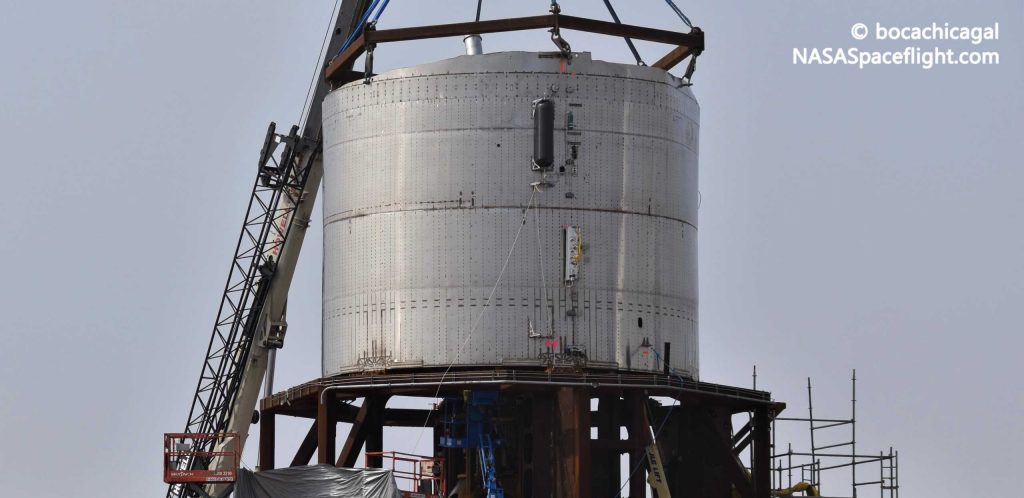
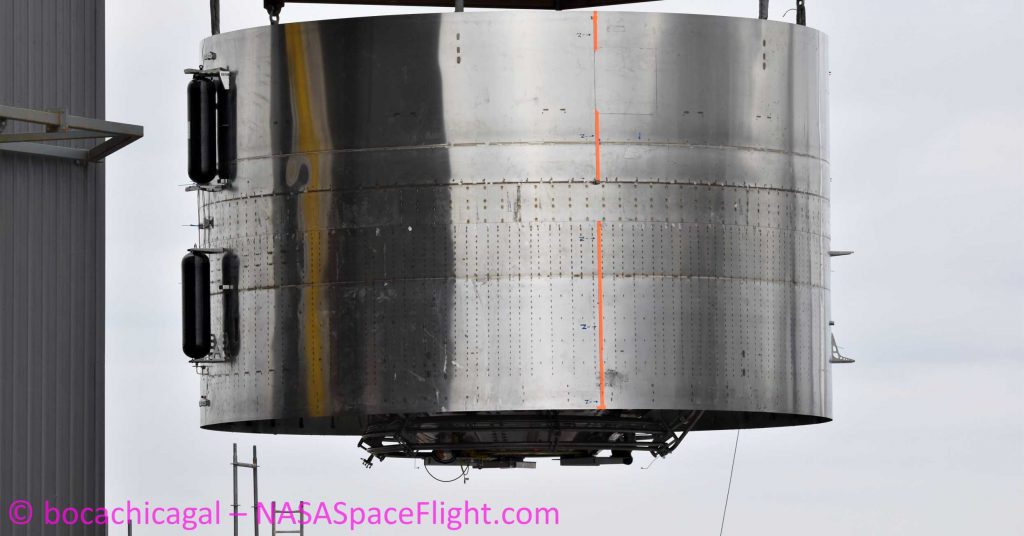
It appears that Musk wound up being partially correct with his initial judgement. On April 15th, eight days after Starship SN3’s remaining aft section was cut in half, the rearmost half – known as the skirt – was spotted stacked beneath a brand new engine section built for SN4. While confirming that a significant part of SN3 will be reused on SN4, it also indicates that only a less critical SN3 remnant was fit to join SpaceX’s next prototype.
Recently confirmed by Musk after a Teslarati article on the topic, Starship SN3’s skirt section – while not the more complex engine section and thrust structure – has been fitted with six landing legs in anticipation of the first full-scale Starship flight tests.
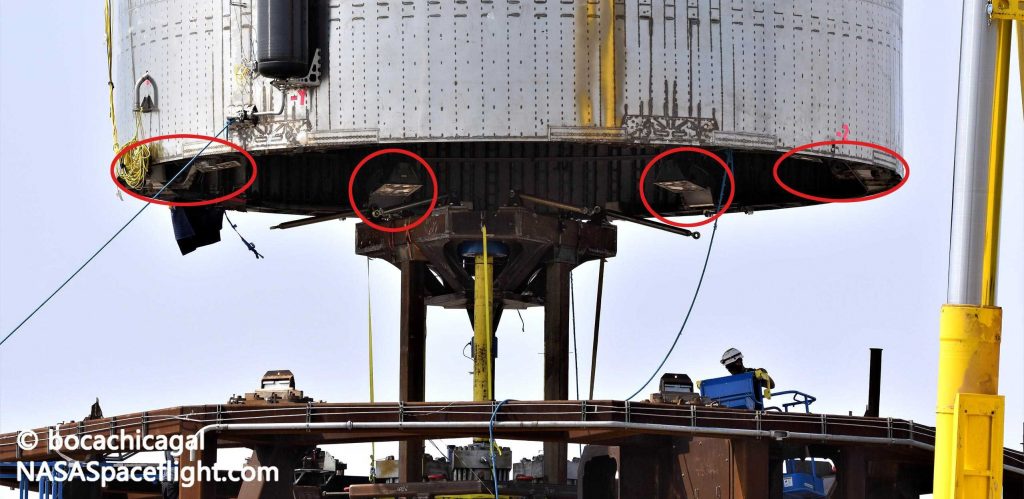

Aside from landing legs, the reused SN3 skirt also includes substantial structural reinforcements, ground umbilical connections for propellant, power, and telemetry, and built-in hold-down clamps. While fairly small in the scope of an entire Starship, SN4’s adoption of SN3’s skirt should help speed the new rocket towards completion and the start of its first test campaign. Barring surprises, SpaceX will almost certainly move Starship SN4 to its nearby testing facilities within the next several days to a week.
Quelle: TESLARATI
----
Update: 21.04.2020
.
SpaceX Starship rocket could move to the launch pad today
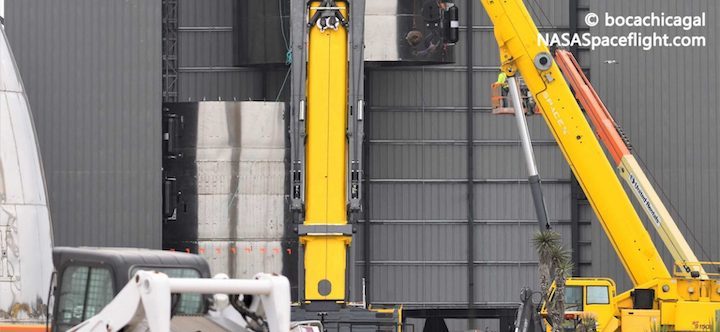
SpaceX has finished stacking its fourth full-scale Starship prototype and public schedules show that the rocket could be moved to a nearby launch and test pad as early as April 20th.
Known as Starship serial number 4 (SN4), the rocket will be the third full-scale vehicle completed since the start of serial production, while Starship Mk1 – the first full-scale prototype – was built far more slowly and with different methods. Mk1 was destroyed during one of its first cryogenic liquid nitrogen ‘proof’ tests in November 2019, nearly nine months after assembly began in February. After Mk1’s failure, SpaceX spent about two months rapidly expanding and upgrading its Boca Chica, Texas Starship factory.
Around the end of January 2020, SpaceX kicked off the production of its first serial prototype – logically deemed SN1. Less than a month after its first steel rings were stacked and welded together, SpaceX transported the completed prototype to the launch pad. On February 28th, what CEO Elon Musk later described as a fault in its engine section “thrust puck” destroyed Starship SN1 during one of its first cryogenic proof tests. Barely a month later and after SN2 was modified into a “thrust puck” test tank and successfully tested, Starship SN3 rolled to the launch pad and was destroyed by operator and test design errors on April 3rd. Now, barely two weeks after SN3, Starship SN4 is about to begin testing.


SpaceX finished stacking its fourth full-scale Starship prototype on April 17th. (NASASpaceflight – bocachicagal)
By all appearances, work on Starship SN4 began around March 23rd, continuing a production schedule that has been consistently completing a full-scale rocket prototype every four or so weeks. While SpaceX has taken the unprecedented step of reusing a section of a prototype (SN3) destroyed during testing, every other aspect of the rocket is new and built more or less from scratch.
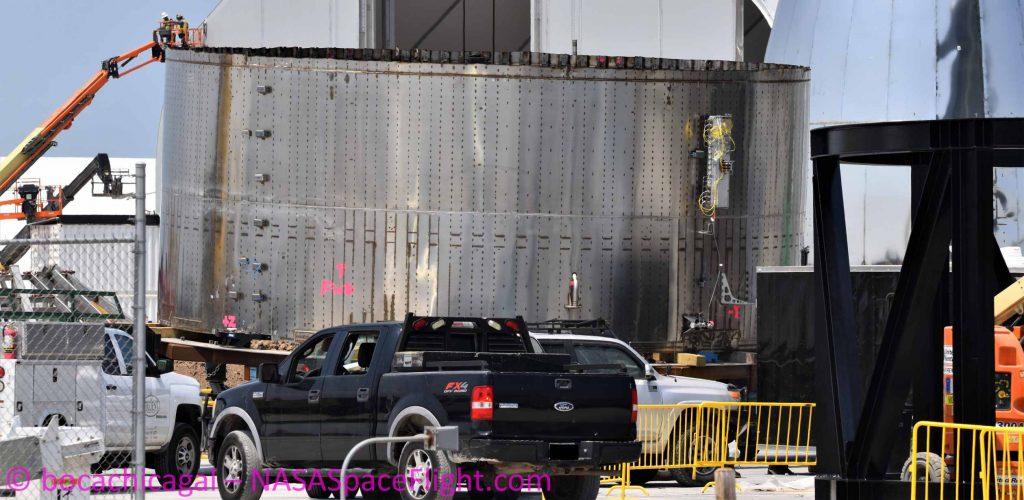

Just two days after Starship SN3’s salvaged skirt and SN4’s new engine section and aft liquid oxygen tank dome were stacked and welded together, SpaceX technicians attached a crane to the upper two-thirds of the rocket’s tank section and stacked it on top of the newly-finished engine section. 24 hours later, SpaceX teams have completed at least one circumferential seam weld, with a second soon to be finished.
Once that last weld is complete and passes inspections, Starship SN4 will be ready to be lifted onto a transporter and rolled down the road to SpaceX’s dedicated launch and test facilities. Of course, like SN3 and SN1 before it, SpaceX will likely still have a few days of work to get Starship SN4 ready for testing once it’s been moved to the pad.
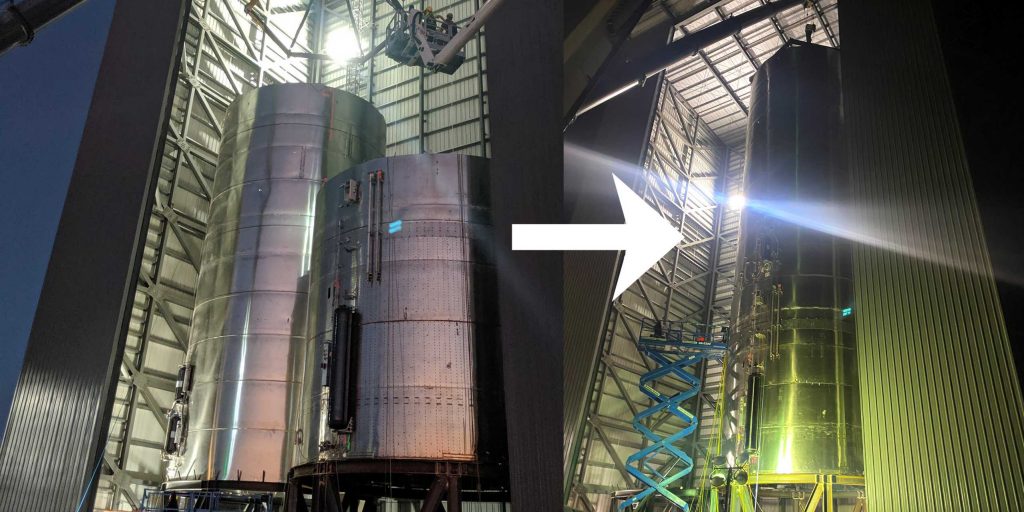
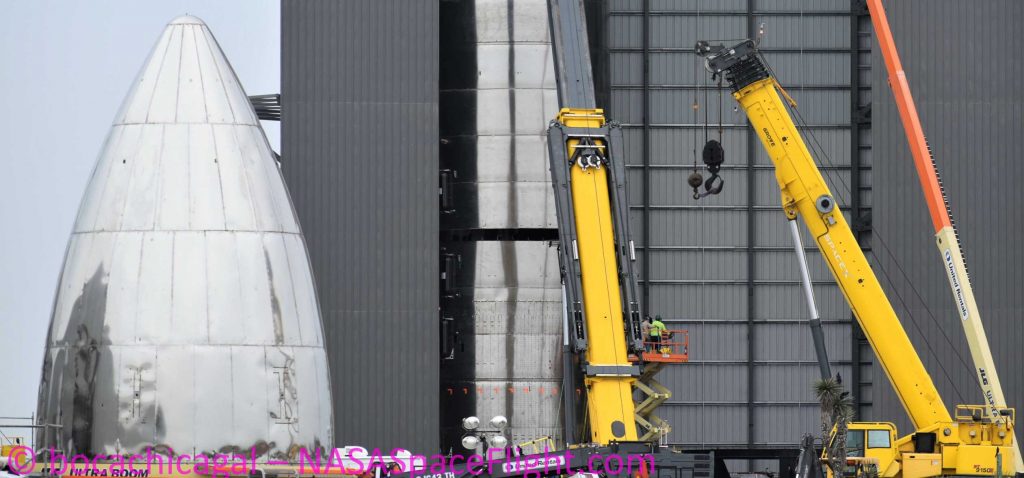
Using Starship SN3’s timeline, Starship SN4 could be transported to the pad as early as April 19th or 20th and ready for testing by April 24th or 25th. This meshes well with a publicly-available road closure schedule, required because SpaceX often needs to close a public highway for certain Starship transport and testing operations. Per Cameron County’s website, SpaceX has a transport-related closure planned on April 20th. The first testing-related closure begins on Sunday, April 26th and lasts from 9am to midnight, with backups on Monday and Tuesday.
As always, delays should come as no surprise with prototype testing, and schedules are always fluid and liable to change at any second. Regardless, it looks like Starship SN4 is perhaps just a week from its first round of testing.
Quelle: TESLARATI
----
Update: 27.04.2020
.
SN4 becomes first full-scale Starship prototype to pass cryogenic proof test

Starship SN4 became SpaceX’s first full-scale Starship prototype to pass a cryogenic proof test on Sunday evening at SpaceX’s launch site in Boca Chica, Texas. The cryogenic proof is one of the first tests necessary to prove the vehicle’s flight-worthiness. With the successful test, SpaceX teams will now work towards a static fire, and then potentially a hop to 150 meters.
SN4 follows the Mk1, SN1, and SN3 full-scale Starship prototypes. The previous full-scale builds all failed cryogenic proof testing. The cryogenic proof is when the Starship is filled with liquid nitrogen to verify that its tanks can withstand flight pressures.
Until Sunday, the only Starship prototype to pass cryogenic proof testing was SN2. However, SN2 was only a partially assembled tank section rather than a full-scale vehicle.
With the prior setbacks, the pressure was on SN4 both literally and figuratively to make it past the cryogenic proof test.
There was optimism ahead of SN4’s proof, as the most recent failure of SN3 was not a result of a welding problem. Welding issues had plagued the previous prototypes. Instead, a simple test configuration mistake caused a substantial pressure difference between the liquid oxygen and methane tanks.
Consequently, the liquid oxygen tank collapsed under the weight of a fully fueled methane tank above it.
This mistake was not one that was likely to be repeated with SN4.
In the end, SN4 passed the cryogenic proof test – hitting 4.9 bar. SpaceX CEO Elon Musk admitted in a tweet that this was “kind of a soft ball…” However, “that’s enough to fly,” he added. It is now expected to move on to engine testing within the coming days.
Currently, SpaceX has three flight-ready Raptor engines waiting for the opportunity to participate in the testing. One of these engines will be installed on SN4.
A Raptor engine is not installed until after the cryogenic proof test, as that test uses hydraulic pistons to simulate the forces created by Raptors during flight.

A Raptor engine in Boca Chica, Texas. Credit: BocaChicaGal for NSF
After SpaceX performs the Raptor installation on SN4, teams will need to conduct checkouts of the engine on the vehicle. These will include gimbal, ignitor, and fuel pre-burner tests, among others.
Only then will SpaceX be ready to attempt a static fire.
April 29 was originally the target for a static fire test, but a one day delay with the cryogenic proof test means that the static fire is now likely targeting no earlier than April 30.
Like SpaceX’s previous static fire attempts with the smaller Starhopper vehicle, it may take a few tries before the company can successfully execute the static fire test. After all, it will be the first time that SpaceX fully fuels a Starship with cryogenic methane and liquid oxygen.
As a result, there is a good chance that small kinks with the ground support equipment will have to be worked out ahead of the static fire.
If all goes well with the static fire, SpaceX may then elect to proceed with a small hop of the Starship SN4 prototype.
Until the testing incident with SN3, SpaceX had planned to hop that vehicle to around 150 meters. SpaceX is currently hoping to now perform that flight with SN4. However, test plans are constantly evolving.
What is certain is that SN4 will be limited to only small hops that do not require a relight of the Raptor engines, according to a tweet from Musk.
Musk explained that this is because the vehicle will not be outfitted with the control surfaces necessary for the vehicle to perform flights where the engines are shut down and then relit.
Either the SN5 or SN6 vehicles will get flaps installed, according to Musk. The flap design has been modified slightly from what SpaceX most recently unveiled with the Starship Mk1 vehicle.
Both of the upcoming SN5 and SN6 vehicles are also expected to get nosecones, something that a Starship prototype has yet to have with it at the pad.
The nose cone will not only house the payloads for the operational Starships, but it will also include the liquid oxygen header tank. The placement of the header tank in the tip of the nose cone helps keep the center of mass of the vehicle forward. This is important for when a Starship is descending through an atmosphere without a payload.
The construction of the SN5 vehicle is already well underway. Numerous sections have already been spotted inside of the large production tents at SpaceX’s Boca Chica facility. Furthermore, a piece of the SN5 tank section was moved into the high bay just hours after SN4 was rolled to the pad on Thursday afternoon.
While SN4 will not be receiving a nose cone, the vehicle has had several heat tiles installed on its surface. A cluster of tiles has been placed along both the engine section and towards the top of the tank section.
The production version of Starship will eventually have an entire side of the vehicle covered in heat tiles to allow the vehicle to safely reenter Earth’s atmosphere and eventually enter the atmospheres of other planets.
Including heat tiles on SN4 will allow SpaceX to gain experience with the mounting process and to verify that the tiles stay properly secured to the Starship during testing.
Quelle: NS
----
Update: 28.04.2020
.
Starship passes key pressurization test

WASHINGTON — A prototype of SpaceX’s Starship next-generation launch vehicle passed a pressurization test April 27, one that had destroyed three of its predecessors.
The Starship SN4 vehicle, on a pad at SpaceX’s facility in Boca Chica, Texas, was loaded with liquid nitrogen, a test designed to confirm its ability to hold cryogenic propellants at pressure. That test came a day after a pressurization test where the tanks were filled with gaseous nitrogen at ambient temperatures.
SpaceX Chief Executive Elon Musk confirmed the cryogenic pressurization test was a success. “SN4 passed cryo proof!” he tweeted.
https://twitter.com/elonmusk/status/1254632509863866368
Three previous Starship prototypes all failed that test in spectacular fashion. In November 2019, a bulkhead in the Starship Mark 1 vehicle, which the company showed off to the media two months earlier, ruptured during a cryogenic pressurization test, sending debris flying. The company said at the time that the outcome “was not completely unexpected.”
A second Starship vehicle, SN1, was also destroyed in a cryogenic tanking test Feb. 28, this time with the vehicle bursting near its base. Musk said that the failure in that test appeared to be with a “thrust puck” at the base of the tank that takes the load from the vehicle’s Raptor engines.
The company then stripped down the next Starship prototype in development, SN2, to its tanks, which alone passed a pressurization test in early March. However, the Starship SN3 vehicle collapsed in another cryogenic pressurization test April 3. Musk said at the time that a test configuration error, rather than a flaw with the vehicle itself, may have caused the vehicle to crumple.
With the cryogenic pressurization test completed, SpaceX will install a Raptor engine in the vehicle and perform a static-fire test as soon as later this week, Musk said. That will be followed by a short “hop” test of the vehicle where it flies to an altitude of 150 meters, similar to a flight by a smaller “Starhopper” vehicle in August 2019.
Musk said in an April 26 tweet that Starship SN4 will be “physically ready” for that flight in a few weeks. “Approvals may take longer.” That flight would require an experimental permit from the Federal Aviation Administration’s Office of Commercial Space Transportation, as was the case for Starhopper’s test flight last August.
SpaceX is working on the next Starship prototype, SN5, which Musk said will have three Raptor engines and the vehicle’s distinctive nose cone section. Musk said in tweets earlier in the month that the vehicle’s flaps and other aerodynamic surfaces “are undergoing redesign for mass reduction & simplicity.” The revised flaps would be installed on either the SN5 or SN6 vehicles.
For all the challenges SpaceX has had testing the Starship prototypes, Musk said the biggest challenge is developing the production line for the vehicle. “The thing that’s really hard is the production system,” he said in an April 24 online discussion hosted by Hack Club, a student group. Musk said in the conversation that he was at Boca Chica overseeing work on Starship.
“Designing a rocket is 1x hard, then building one of it is 10x,” he said. “Building the production system is at least 100x, possibly a 1000x.”
Quelle: SN
